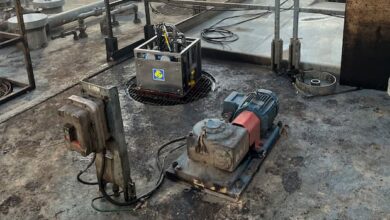Using right selection criteria key to successful slim-well designs with solid expandables
By Tony Furniss, Jerry Fritsch, Roy Campbell, Enventure Global Technology

Economic factors drive every aspect of the oil and gas industry. Operators are emphatic about maximizing the production potential of past, present and future wells. The adage of working smarter rather than harder is reflected in the benefits of using a slim-well wellbore design.
Wells that are “slimmed” using solid expandable technology offer savings across the entire drilling process – from increased rate of penetration (ROP) to reduction in tangibles and consumables. Slimmer wells also can significantly reduce the environmental impact of a drilling operation. Additionally, these systems can help operators reach reserves that were previously unattainable.
When the use of a solid expandable system is planned to create a slim-well design, the initial financial impact and well construction phase time can be reduced and the well can become productive more quickly.
EXPANDABLE TECHNOLOGY
The first commercial application of a solid expandable system occurred in 1999. Since that time, installations have become increasingly more challenging – from shallow installations (short 600-ft liners) to the current record of over 6,900 ft of continuously expanded pipe in offshore environments. Additionally, expandables have been run in mud weights above 20 ppg, in wellbores exceeding horizontal deviations of over 100° and in depths in excess of 28,000 ft.
When mitigating geological hazards, solid expandable tubulars provide an alternative to conventional casing design, which may require premature placement of casing points. Solid expandable technology systems not only can mitigate problems as they occur but also provide a response that proactively addresses conditions that pose potential problems.
SLIM-WELL DESIGN
By definition, a slim-well design uses a strategically planned single solid expandable liner in a wellbore that reduces the wellbore architecture above the expandable liner, while maintaining the original casing design and completion size below the expandable liner. This application is novel in that it rethinks the placement and use of one string of casing to influence the entire wellbore.
The ability to reduce the wellbore architecture above the solid expandable liner while maintaining the original completion size has the notable advantage of drilling a smaller hole at a faster pace. Reducing the required hole size increases ROP, which reduces the number of rig days.
Some applications eliminate underreaming for entire hole sections. Additionally, a slimmer wellbore decreases the steel tonnage required, the bits and bottomhole assembly sizes, the cuttings generated and subsequent disposal, the mud and cement volumes, etc.
SELECTING THE RIGHT WELL – ONSHORE

Identifying potential candidate wells is key to successfully implementing a slim-well design. In an onshore design, a notable characteristic is the presence of a short conventional casing string that can be replaced by the solid expandable liner. This enables the wellbore above the solid expandable liner to be slimmed (diameter reduced).
Three key pieces of data must be evaluated to ensure the slim-well design is applicable: formation (hard, soft, shale, etc), wellbore conditions (stability, pore pressure, etc) and well complexity (number of casing strings, casing setting points, etc).
The above criteria have proven to be key elements in a successful slim-well design. However, there are opportunities in environmentally sensitive and remote areas where a slim-well design can reduce a rig’s footprint.
ONSHORE WELL DESIGN
A drilling campaign in the US used a slim-well design and realized a 20% savings on well construction cost. The operator incorporated solid expandable technology into a well-slimming program that reduced upper hole sizes, which improved ROP and reduced overall expenditures.
Incorporating a solid expandable system enabled the operator to drill a 14 ¾-in. surface hole instead of a 17 ½-in. hole, allowing drillout of surface pipe one day early. Below the surface pipe, the operator drilled a 9 7/8-in. hole (drilled at 3 days/1,000 ft) versus a 12 ¼-in. hole (drilled at 4.8 days/1,000 ft). This 37% increase in ROP saved more than 23 days of rig time.
After installing a 7 5/8-in. intermediate casing string, the next hole section was drilled, and a 6 in.-by-7 5/8 in. solid expandable liner was installed. The expandable liner covered a loss-circulation zone, which enabled the use of a higher-density fluid required to reach the reservoir. A 4 ½-in. production casing that followed the expandable liner’s installation to total depth (TD) facilitated the planned production (Figure 1).
To further reduce costs and improve efficiency, the operator assessed options to remove the need for underreaming and cementing the solid expandable liner (an average of five to seven rig days). The rock being drilled was hard; therefore, swellable elastomers were used to attain zonal isolation in the wellbore where the solid expandable liner was installed.
In the new slim-well design, the operator ran the 6 in.-by-7 5/8 in. open-hole liner and set the isolation anchor (swellable elastomers just above the shoe) in a competent shale formation. An oil-based pill was pumped to activate the swellable elastomers. As the expansion progressed, the swellable elastomers compressed into the formation just above the solid expandable liner shoe. The remainder of the liner was expanded and shoe drilled out. A successful shoe test conducted to 16 ppg-equivalent mud weight indicated that the now-compressed swellable elastomers had effectively sealed and isolated the loss zone, which was now behind the solid expandable liner (Figure 2).
The use of swellable elastomers in lieu of underreaming and cementing further reduced the days-to-depth – US$300,000 in additional savings. The slimmer wellbore’s success prompted the operator to continue the slim-well program, which totaled 47 wells.
SELECTING THE RIGHT WELL – OFFSHORE

Hole instability is common in upper hole sections of the wellbore due to larger-diameter assemblies drilling and/or underreaming through very soft formations. Planning an additional solid expandable liner higher in the primary well design can push the subsequent casing seats deeper and eliminate the need to underream unpredictable lower sections. This improves the odds of reaching total depth (TD) successfully with the desired hole size.
One example of the unpredictability of these large-diameter upper-hole sections is an eight-well project drilled offshore UK. Four of the wells were junked in the 26-in. hole section, representing 21 days of nonproductive time (NPT). This and similarly documented examples warrants an evaluation of utilizing an expandable liner in the upper hole.
While still conceptual, there are two solid expandable options to consider. The objective of both is to:
• Slim down the drilling of 26-in. hole to 19 ¾ in.
• Drill the top hole in a single operation
• Replace 20-in. conventional pipe with a 16-in. expandable liner.
• Provide post-expansion drill ahead with a 17 ½-in. bit.
• Remove need to underream the next hole section below the expandable liner.
Option 1:
In the first example, 20-in. casing is run; it is pre-loaded on the 18 ¾-in. wellhead and hung near the shoe of the 30-in. conductor pipe. The next hole section is drilled to 19 ¾ in. instead of 26 in. The reduced diameter would provide increased hole stability and better hole cleaning due to higher annular velocities. The smaller hole would also have an increased ROP, in some areas potentially resulting in a three-fold increase.
The 16 in.-by-20 in. solid expandable liner would be run and expanded. Because the expanded liner provides a 17.505-in. drift, providing a 17 ½-in. drill ahead, the next hole section would not be underreamed; standard casing (13 3/8 in. to 14 in.) could be run without special connection requirements (Figure 3).
Option 2:
The second example would use a combination string of 30 in.-by-20 in. casing to start the well. Only enough 20 in. (approximately 200 ft) would be required for the 16 in.-by-20 in. expandable liner to anchor into. After setting the 30 in.-by-20 in. casing, the hole would be drilled to only 19 ¾ in. rather than 26 in., thereby maximizing hole stability.
The 16 in.-by-20 in. solid expandable liner (17.505-in. drift, as in Option 1), would be run and expanded. Due to the 17 ½-in. drill ahead, the next hole section would not require underreaming, and standard casing ranging from 13 3/8 in. to 14 in. could be run without special connection requirements (Figure 3). The same advantages are realized in both options.
IN THE END
Solid expandable technology in a slim-well design can add significant value to the overall well economics. That value is directly related to strategic placement of the expandable liner – either higher in the wellbore in offshore projects, or lower in the well design to mitigate difficult formations. In both instances, ROP can be increased, well design can be optimized and a reduction in tangibles and consumables can be realized.
This article is based on a presentation at the IADC World Drilling 2010 Conference & Exhibition, 16-17 June, Budapest, Hungary.




